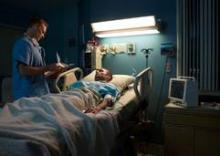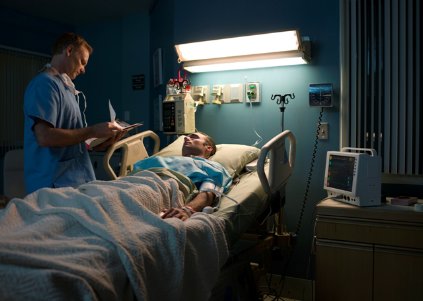User login
A quality improvement program cut postoperative pneumonia rates by 43.6%, investigators reported July 23 in JAMA Surgery.
The small, single-center retrospective cohort study is the first to present long-term findings for such a program, said Dr. Hadiza Kazaure at Stanford (Calif.) University and her associates.
The program, which investigators started at a Stanford-affiliated Veterans Affairs hospital, included coughing and deep-breathing exercises with incentive spirometry, a twice-daily oral chlorhexidine hygiene, ambulation with pain control, elevating the head of the bed by 30 degrees and sitting for meals, educating surgical nursing staff about their roles in preventing pneumonia, and automating physician orders for pneumonia prevention, the researchers said (JAMA Surg. 2014 July 23 [doi:10.1001/jamasurg.2014.1216]).
The investigators calculated postimplementation rates of ward-acquired pneumonia in all noncardiac, unventilated surgical patients in the 5 years after the program started, they said.
Among 4,099 hospitalized patients who were at risk, 18 (0.44%) developed postoperative pneumonia, a 43.6% drop from the preprogram rate of 0.78%, the investigators reported.
By comparison, the postintervention rate for the American College of Surgeons National Surgical Quality Improvement Program (ACS-NSQIP) was 582% higher than that of the VA hospital for 2008-2012. By achieving the VA hospital program’s results, the hospitals in the ACS-NSQIP could save about $280 million, Dr. Kazaure and her associates said.
The database abstraction methods used to choose patients were validated, but nonetheless could have caused selection errors. Also, few patients developed pneumonia, which kept the investigators from tracking trends over time on the ward, they said. "Based on published data, we used a national average of $46,400 cost of care per postoperative pneumonia case to estimate potential cost savings in our analyses," they added. "The validity of cost estimates in this study to individual hospitals must be considered because geographic variation in cost of care is well established."
The authors reported no funding sources or conflicts of interest.
The "remarkably low" baseline rate of postoperative pneumonia "calls into question the adequacy of detection and reporting of pneumonia" on the surgical ward, making findings "of somewhat less consequence," Dr. Catherine Lewis said.
"Moreover, the authors’ program was implemented and evaluated over a period in which there was an ongoing shift from open to laparoscopic or robotic surgical techniques, which has been shown to significantly decrease the rates of postoperative pneumonia, particularly in colorectal and prostate operations," she said.
The authors did not examine whether changes in patient care or surgical technique affected postoperative pneumonia rates, Dr. Lewis noted. She pointed to other research showing that using a neuraxial blockade instead of general anesthesia led to a significant drop in postoperative pneumonia, as did using selective nasogastric decompression (Ann. Intern. Med. 2006;144:596-608).
Previously, the authors of the current study reported that postoperative non–ventilator-associated pneumonia rates did not change after they started their program, Dr. Lewis said. The number of ward cases decreased, but the number of non–ventilator-associated pneumonia intensive care unit cases increased, so the decrease could reflect redistribution in the location of patients, she said.
But the authors also deserved praise for developing and starting a relatively cost- and time-efficient quality improvement measure, Dr. Lewis added. She said that such programs could increase awareness and education among health care providers who care for patients after surgery.
Dr. Lewis specializes in general, critical care, and trauma surgery at the University of California, Los Angeles. The remarks were excerpted from her invited editorial accompanying Dr. Kazaure’s report (JAMA Surg. 2014 July 23 [doi:10.1001/jamasurg.2014.1249]).
The "remarkably low" baseline rate of postoperative pneumonia "calls into question the adequacy of detection and reporting of pneumonia" on the surgical ward, making findings "of somewhat less consequence," Dr. Catherine Lewis said.
"Moreover, the authors’ program was implemented and evaluated over a period in which there was an ongoing shift from open to laparoscopic or robotic surgical techniques, which has been shown to significantly decrease the rates of postoperative pneumonia, particularly in colorectal and prostate operations," she said.
The authors did not examine whether changes in patient care or surgical technique affected postoperative pneumonia rates, Dr. Lewis noted. She pointed to other research showing that using a neuraxial blockade instead of general anesthesia led to a significant drop in postoperative pneumonia, as did using selective nasogastric decompression (Ann. Intern. Med. 2006;144:596-608).
Previously, the authors of the current study reported that postoperative non–ventilator-associated pneumonia rates did not change after they started their program, Dr. Lewis said. The number of ward cases decreased, but the number of non–ventilator-associated pneumonia intensive care unit cases increased, so the decrease could reflect redistribution in the location of patients, she said.
But the authors also deserved praise for developing and starting a relatively cost- and time-efficient quality improvement measure, Dr. Lewis added. She said that such programs could increase awareness and education among health care providers who care for patients after surgery.
Dr. Lewis specializes in general, critical care, and trauma surgery at the University of California, Los Angeles. The remarks were excerpted from her invited editorial accompanying Dr. Kazaure’s report (JAMA Surg. 2014 July 23 [doi:10.1001/jamasurg.2014.1249]).
The "remarkably low" baseline rate of postoperative pneumonia "calls into question the adequacy of detection and reporting of pneumonia" on the surgical ward, making findings "of somewhat less consequence," Dr. Catherine Lewis said.
"Moreover, the authors’ program was implemented and evaluated over a period in which there was an ongoing shift from open to laparoscopic or robotic surgical techniques, which has been shown to significantly decrease the rates of postoperative pneumonia, particularly in colorectal and prostate operations," she said.
The authors did not examine whether changes in patient care or surgical technique affected postoperative pneumonia rates, Dr. Lewis noted. She pointed to other research showing that using a neuraxial blockade instead of general anesthesia led to a significant drop in postoperative pneumonia, as did using selective nasogastric decompression (Ann. Intern. Med. 2006;144:596-608).
Previously, the authors of the current study reported that postoperative non–ventilator-associated pneumonia rates did not change after they started their program, Dr. Lewis said. The number of ward cases decreased, but the number of non–ventilator-associated pneumonia intensive care unit cases increased, so the decrease could reflect redistribution in the location of patients, she said.
But the authors also deserved praise for developing and starting a relatively cost- and time-efficient quality improvement measure, Dr. Lewis added. She said that such programs could increase awareness and education among health care providers who care for patients after surgery.
Dr. Lewis specializes in general, critical care, and trauma surgery at the University of California, Los Angeles. The remarks were excerpted from her invited editorial accompanying Dr. Kazaure’s report (JAMA Surg. 2014 July 23 [doi:10.1001/jamasurg.2014.1249]).
A quality improvement program cut postoperative pneumonia rates by 43.6%, investigators reported July 23 in JAMA Surgery.
The small, single-center retrospective cohort study is the first to present long-term findings for such a program, said Dr. Hadiza Kazaure at Stanford (Calif.) University and her associates.
The program, which investigators started at a Stanford-affiliated Veterans Affairs hospital, included coughing and deep-breathing exercises with incentive spirometry, a twice-daily oral chlorhexidine hygiene, ambulation with pain control, elevating the head of the bed by 30 degrees and sitting for meals, educating surgical nursing staff about their roles in preventing pneumonia, and automating physician orders for pneumonia prevention, the researchers said (JAMA Surg. 2014 July 23 [doi:10.1001/jamasurg.2014.1216]).
The investigators calculated postimplementation rates of ward-acquired pneumonia in all noncardiac, unventilated surgical patients in the 5 years after the program started, they said.
Among 4,099 hospitalized patients who were at risk, 18 (0.44%) developed postoperative pneumonia, a 43.6% drop from the preprogram rate of 0.78%, the investigators reported.
By comparison, the postintervention rate for the American College of Surgeons National Surgical Quality Improvement Program (ACS-NSQIP) was 582% higher than that of the VA hospital for 2008-2012. By achieving the VA hospital program’s results, the hospitals in the ACS-NSQIP could save about $280 million, Dr. Kazaure and her associates said.
The database abstraction methods used to choose patients were validated, but nonetheless could have caused selection errors. Also, few patients developed pneumonia, which kept the investigators from tracking trends over time on the ward, they said. "Based on published data, we used a national average of $46,400 cost of care per postoperative pneumonia case to estimate potential cost savings in our analyses," they added. "The validity of cost estimates in this study to individual hospitals must be considered because geographic variation in cost of care is well established."
The authors reported no funding sources or conflicts of interest.
A quality improvement program cut postoperative pneumonia rates by 43.6%, investigators reported July 23 in JAMA Surgery.
The small, single-center retrospective cohort study is the first to present long-term findings for such a program, said Dr. Hadiza Kazaure at Stanford (Calif.) University and her associates.
The program, which investigators started at a Stanford-affiliated Veterans Affairs hospital, included coughing and deep-breathing exercises with incentive spirometry, a twice-daily oral chlorhexidine hygiene, ambulation with pain control, elevating the head of the bed by 30 degrees and sitting for meals, educating surgical nursing staff about their roles in preventing pneumonia, and automating physician orders for pneumonia prevention, the researchers said (JAMA Surg. 2014 July 23 [doi:10.1001/jamasurg.2014.1216]).
The investigators calculated postimplementation rates of ward-acquired pneumonia in all noncardiac, unventilated surgical patients in the 5 years after the program started, they said.
Among 4,099 hospitalized patients who were at risk, 18 (0.44%) developed postoperative pneumonia, a 43.6% drop from the preprogram rate of 0.78%, the investigators reported.
By comparison, the postintervention rate for the American College of Surgeons National Surgical Quality Improvement Program (ACS-NSQIP) was 582% higher than that of the VA hospital for 2008-2012. By achieving the VA hospital program’s results, the hospitals in the ACS-NSQIP could save about $280 million, Dr. Kazaure and her associates said.
The database abstraction methods used to choose patients were validated, but nonetheless could have caused selection errors. Also, few patients developed pneumonia, which kept the investigators from tracking trends over time on the ward, they said. "Based on published data, we used a national average of $46,400 cost of care per postoperative pneumonia case to estimate potential cost savings in our analyses," they added. "The validity of cost estimates in this study to individual hospitals must be considered because geographic variation in cost of care is well established."
The authors reported no funding sources or conflicts of interest.
FROM JAMA SURGERY
Key clinical point: Cost-effective quality improvement programs can potentially prevent postoperative pneumonia in unventilated patients.
Major finding: Among 4,099 hospitalized patients at risk between 2008 and 2012, 18 (0.44%) developed postoperative pneumonia, a 43.6% decrease from the preintervention rate of 0.78%.
Data source: Retrospective cohort study of all noncardiac surgical patients who acquired postoperative pneumonia on a Veterans Affairs hospital ward from 2008 to 2012.
Disclosures: The authors reported no funding sources or conflicts of interest.

